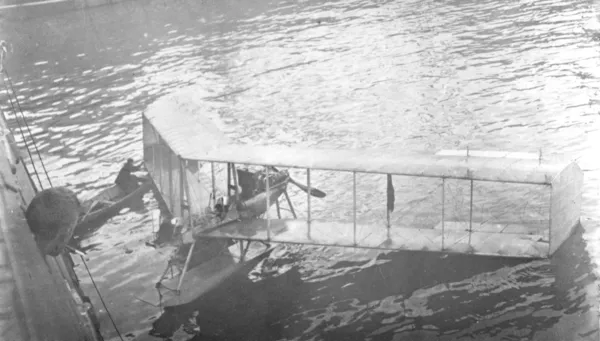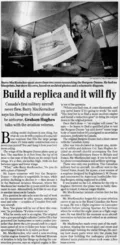AH-7 (Total: 2, Canadian: 1, Group 0)
Burgess-Dunne AH-7

The Burgess-Dunne AH-7 was a floatplane modified American license build of the land plane Dunne D.8 . There were only two aircraft manufactured by the Burgess Company in Marblehead, Massachusetts in 1914: a single-seater AH-7 and a double-seater AH-10, which were intended for the US Navy . However, the second machine was sold to the Canadian Aviation Corps.
The designations AH-7 and AH-10 corresponded to the system used by the US Navy until 1920 in which the task identifier "AH" stood for float planes and the following number for the service serial number. The AH-7 was the seventh floatplane that the US Navy had procured.The Dunne D.8 of 1912 was a tailless swept wing biplane, designed by J.W. Dunne to have inherent stability. One example was supplied to RAE Farnborough. License-built Burgess-Dunne models were used by the US Signal Corps and the USN. One was flown by the short-lived Canada Aviation Corps, its first and only warplane.
The Burgess Company and Curtiss, based in Marblehead, Massachusetts, gained the US manufacturing rights and built a series of aircraft based on the D.8. They became known as Burgess-Dunne machines and were mostly single-float planes. The first flew in March 1914. Apart from wingtip floats the wings were identical to those of the D8, but the fuselage was revised with a distinct nacelle containing a more enclosed cockpit. The aircraft was a single-seater, with the heavier 100 hp (75 kW) Curtiss OXX2 water-cooled engine moved forwards, shortening the fuselage and with its radiator placed between the engine and the pilot. The single float was 17 ft 8 in (5.38 m) long, shallow and flat bottomed viewed from in front, with a single step. The prototype behaved well in the air and on the water. The second machine was very similar to the first, but room was made for a second seat by replacing the single fuselage mounted radiator with a pair fixed to the rear float struts.
The second machine a Burgess-Dunne BD, was bought by the Canadian government for the Canadian Aviation Corps (CAC) and was their first military aircraft. It was shipped to Europe on the SS Athenia for service in the First World War, but was seriously damaged in transit and not used.
The CAC came into existence early in the First World War partly due to the enthusiasm of a Galt, Ontario automobile mechanic named Ernest Loyd Janney. Despite lacking expertise in aeronautics, Janney managed to convince Sam Hughes, Canada's Minister of Defense and Militia, to purchase an aircraft (which was against National Defense Policy at the time). Janney was made the provisional commander, and given the rank of captain. The other original member to the CAC was Lieutenant William F. Sharpe, a pilot.
The Department of National Defense gave Captain Janney $5,000 to purchase one aircraft and authorized him to travel to the USA to make the purchase. Lieutenant Sharpe went to England to fly in the Royal Flying Corps (RFC), later the RAF. Captain Janney visited all the major aircraft company factories and on 12 Sep 1914, he visited the Burgess plant in Marblehead Harbour, Massachusetts. Captain Janney observed a demonstration of the aircraft and was very impressed. He returned to Canada and on 16 Sep 1914 the CAC was officially commissioned. On 17 Sep, Captain Janney returned to Marblehead Harbour and made an offer on the aircraft for $5,000, with one condition, the CAC must have the aircraft immediately due to the Canadian Armys war requirements.
The aircraft had originally been built under contract for the Republican candidate and Assistant Secretary Treasurer A. Pait Andrews who was in a race to purchase the plane with rival politician Congressman Gardner. The aircraft was ready to be collected on 19 Sep, but the Burgess Company, needing money, accepted Captain Janney's offer. This came as a surprise to Andrews, who thought Gardner made off with his plane. The aircraft was shipped to Lake Champlain and then flown to Quebec City on 21 Sep 1914 by Burgess test pilot, Clifford Lawrence Webster and his passenger, Captain Janney. This was the delivery of the first military aircraft purchased by the Canadian government.
When the Burgess-Dunne landed in Quebec City it was disassembled and packed for shipment overseas on the SS Athena. It was delayed on 30 Sep 1914, and when it arrived in England it was discovered that during the shipping process the aircraft had been damaged beyond use and never saw the skies again. The Burgess-Dunne, Canada's first military aircraft was scrapped on Salisbury plain in the UK. As for the CAC, a year after its creation, it slipped into obscurity. Captain Janney's service was terminated when he returned from England. No parts of the original aircraft survive, but a replica is now on display in the National Air Force Museum of Canada and CFB Trenton, Ontario. (NAFMC) Wikipedia Harold A. Skaarup web pages with revisions
AH-7 serial RE17706
s/n RE17706
Burgess Company
RE 17706
Known Units:
The Burgess-Dunne was a unique hydro-plane design with swept-back wings providing inherent stability. The aircraft had originally been designed by Lieutenant John William Dunne, an early British experimenter, and was manufactured under license in the United States by the Burgess Company, a boat-building firm that supplied several models to the U.S. Navy. The aircraft was purchased and flown to Quebec City, where Canada's First Contingent was forming. The design of the aircraft limited its military usefulness but it was, in fact, disassembled and shipped overseas to England with the First Canadian Contingent. Once there, the aircraft was never flown and it rotted into a "heap of worthless junk" on Salisbury Plain where the Canadian contingent was in training.Source RAF Commands and Canadian Combat and Support Aircraft: A Military Compendium by T.F.J. Leversedge © 2007.
last update: 2025-November-19
1915 Struck off Strength in Britain on Salisbury Plain 2020-08-13
